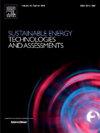美国住宅楼安装热泵的趋势
IF 7
2区 工程技术
Q1 ENERGY & FUELS
Sustainable Energy Technologies and Assessments
Pub Date : 2024-11-22
DOI:10.1016/j.seta.2024.104080
引用次数: 0
摘要
本文量化了热泵在美国住宅建筑中安装和应用的最新趋势。为实现量化,本研究对美国 2020 年住宅建筑能源调查 (RECS) 数据库进行了描述,并对近年来可能出现的技术进步进行了讨论。在未进行详细审查的情况下,2020 年 RECS 中美国住宅建筑中热泵的数量与 2015 年 RECS 相比有所增加。本文还通过分析表明,从 2015 年到 2020 年,热泵的增幅相对较低。本文最后对美国的热泵激励措施进行了全面讨论,并对热泵的安装提出了一些实用建议,以确保在任何去碳化途径的整体发展中都包含未来电气化的内容。最后,本研究比较了美国与其他国家的热泵安装情况。鉴于对气候变化的担忧,研究结果对美国住宅建筑电气化所需的未来政策和技术进步具有重要意义。本文章由计算机程序翻译,如有差异,请以英文原文为准。
Trends for the installation of heat pumps in the US residential buildings
This paper quantifies recent trends in the installation and deployment of heat pumps in the U.S. residential buildings. To meet this quantification, this study characterizes the 2020 Residential Building Energy Survey (RECS) database in the U.S. and provides discussions on the potential technological advances that have occurred in recent years. Without a detailed review, the number of heat pumps in U.S. residential building stock in 2020 RECS is increased compared to 2015 RECS. The analysis provides a detailed distribution on the trends of heat pumps installed in the U.S. This paper also shows that the increase of heat pump from 2015 to 2020 is relatively low through our analyses. The paper concludes with a comprehensive discussion on the heat pump incentives in the U.S. and a few practical recommendations for the installation of heat pumps to ensure future electrification aspects are included in a holistic development of any decarbonization pathway. Finally, this study compares the heat pump installation in the U.S. with other countries. The results have implications for the future policies and technological advances needed to electrify residential buildings in the U.S. given the concerns over climate change.
求助全文
通过发布文献求助,成功后即可免费获取论文全文。
去求助
来源期刊

Sustainable Energy Technologies and Assessments
Energy-Renewable Energy, Sustainability and the Environment
CiteScore
12.70
自引率
12.50%
发文量
1091
期刊介绍:
Encouraging a transition to a sustainable energy future is imperative for our world. Technologies that enable this shift in various sectors like transportation, heating, and power systems are of utmost importance. Sustainable Energy Technologies and Assessments welcomes papers focusing on a range of aspects and levels of technological advancements in energy generation and utilization. The aim is to reduce the negative environmental impact associated with energy production and consumption, spanning from laboratory experiments to real-world applications in the commercial sector.
 求助内容:
求助内容: 应助结果提醒方式:
应助结果提醒方式:


